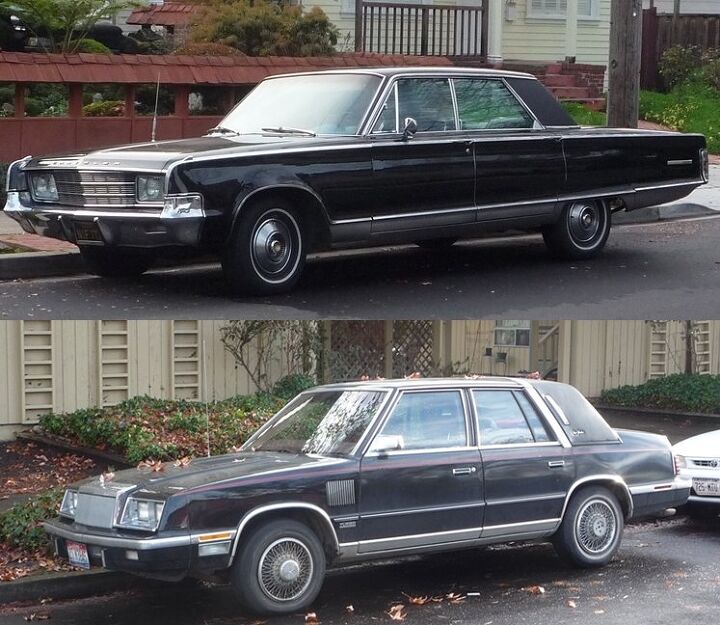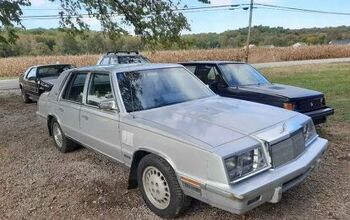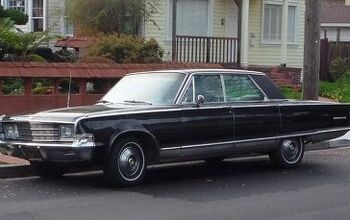Curbside Classic: 1985 Chrysler New Yorker

Let’s hold our nose and consider the decline and fall of the Chrysler New Yorker. Twenty years earlier, that name typified the grace, comfort, style and performance that New Yorkers had been know for since the first New Yorker ran off the lines in 1939. The energy crisis and the decline of the big car brought on a prolonged slide that should have ended with its retirement in 1982. But Lee Iaccoca would have none of that: the New Yorker would be reinKarnated! Add three inches to that infinitely malleable K-car platform, and slap on a healthy dollop of all the usual faux-luxury car trappings of the time, and presto: a mini-me New Yorker. Just in case you forgot what it looked like in its prime, here’s the before and after:
But don’t think just because you were getting a four-cylinder Reliant with a couple of hundred dollars worth of plasticky body add-ons bought in bulk from J C Whitney and a turbo conversion with all the subtlety and refinement of a home-brew job, that the new New Yorker was going to be a bargain. Inflation adjusted, both of these cars cost about the same: $27k in today’s dollars.
Chrysler hadn’t yet invented a V6 engine, so slapping a turbo on the 2.2 liter four was the only game in the big apple’s attempt to invoke luxury car performance. That is, if you were willing to shell out the extra bucks for it, because Lee had no compunction about the New Yorker having a 101 hp four as the standard engine. Your investment in turbo lag worthy of a stubborn mule yielded a magnificent 146 hp, once it spooled up. The little turbo four might have been some fun in the Omni GLH with a stick, but in the New Yorker teamed up with a three-speed automatic it was about as sporty as when the same combination was put to work powering a long-wheelbase Grand Caravan.
But once ensconced in that luxurious interior of fine Corinthian leather, all was well with the world. The instant response and torque of a healthy 413 V8 was now just a distant memory. Press on that go pedal, and eventually something happened, in herky jerky fashion. But it was all worth it, to save gas. Ironically, gas prices were already plummeting by the time the New Yorker hit the streets in 1983. But there was always the Fifth Avenue, a former Dodge Aspen also given the full Iacocca treatment. Its 318 V8 had less horsepower (140) but some vestige of low-end torque.
Some of the finer examples of what your $14k bought you in 1985: wire wheel covers, fake fender vents and a turbo badge. We’ll have to go to the next picture to show you the hood vents, the true mark of a refined luxury car.
There they are! The package is complete. Your New Yorker awaits you, sir!
I’ve been getting a bit tired of the endless “these all rusted out in three years” comments to Curbside Classics, and my inner Kraut is on the verge of going all Bertel and banning anyone who ever does that again :), but I’m going to postpone it for this car. So help yourself, and pile on with all the rusty comments you want, because it would make me happy to know that some parts of the country aren’t plagued with these things.

More by Paul Niedermeyer
Latest Car Reviews
Read moreLatest Product Reviews
Read moreRecent Comments
- Kwik_Shift_Pro4X Thankfully I don't have to deal with GDI issues in my Frontier. These cleaners should do well for me if I win.
- Theflyersfan Serious answer time...Honda used to stand for excellence in auto engineering. Their first main claim to fame was the CVCC (we don't need a catalytic converter!) engine and it sent from there. Their suspensions, their VTEC engines, slick manual transmissions, even a stowing minivan seat, all theirs. But I think they've been coasting a bit lately. Yes, the Civic Type-R has a powerful small engine, but the Honda of old would have found a way to get more revs out of it and make it feel like an i-VTEC engine of old instead of any old turbo engine that can be found in a multitude of performance small cars. Their 1.5L turbo-4...well...have they ever figured out the oil dilution problems? Very un-Honda-like. Paint issues that still linger. Cheaper feeling interior trim. All things that fly in the face of what Honda once was. The only thing that they seem to have kept have been the sales staff that treat you with utter contempt for daring to walk into their inner sanctum and wanting a deal on something that isn't a bare-bones CR-V. So Honda, beat the rest of your Japanese and Korean rivals, and plug-in hybridize everything. If you want a relatively (in an engineering way) easy way to get ahead of the curve, raise the CAFE score, and have a major point to advertise, and be able to sell to those who can't plug in easily, sell them on something that will get, for example, 35% better mileage, plug in when you get a chance, and drives like a Honda. Bring back some of the engineering skills that Honda once stood for. And then start introducing a portfolio of EVs once people are more comfortable with the idea of plugging in. People seeing that they can easily use an EV for their daily errands with the gas engine never starting will eventually sell them on a future EV because that range anxiety will be lessened. The all EV leap is still a bridge too far, especially as recent sales numbers have shown. Baby steps. That's how you win people over.
- Theflyersfan If this saves (or delays) an expensive carbon brushing off of the valves down the road, I'll take a case. I understand that can be a very expensive bit of scheduled maintenance.
- Zipper69 A Mini should have 2 doors and 4 cylinders and tires the size of dinner plates.All else is puffery.
- Theflyersfan Just in time for the weekend!!! Usual suspects A: All EVs are evil golf carts, spewing nothing but virtue signaling about saving the earth, all the while hacking the limbs off of small kids in Africa, money losing pits of despair that no buyer would ever need and anyone that buys one is a raging moron with no brains and the automakers who make them want to go bankrupt.(Source: all of the comments on every EV article here posted over the years)Usual suspects B: All EVs are powered by unicorns and lollypops with no pollution, drive like dreams, all drivers don't mind stopping for hours on end, eating trays of fast food at every rest stop waiting for charges, save the world by using no gas and batteries are friendly to everyone, bugs included. Everyone should torch their ICE cars now and buy a Tesla or Bolt post haste.(Source: all of the comments on every EV article here posted over the years)Or those in the middle: Maybe one of these days, when the charging infrastructure is better, or there are more options that don't cost as much, one will be considered as part of a rational decision based on driving needs, purchasing costs environmental impact, total cost of ownership, and ease of charging.(Source: many on this site who don't jump on TTAC the split second an EV article appears and lives to trash everyone who is a fan of EVs.)







































Comments
Join the conversation
I have a 1985 Chrysler New Yorker. has been doing ok till recently. Mechanic tells me it would cost more to fix then it is worth. Then I see a guy selling his for $6000. But it is all I have so if anyone can give me pointers that would be great.
Growing up, we always had multiple cars - at least 4, not including the van. My Dad always had to have a van and a sports car, and he's had some weird ones over the years. Not many people had ever heard of Saab's Sonett, but he had three of them; two which ran and one that needed work. But the first car I started to learn to drive was the 84 New Yorker he'd bought new (traded in an 83 Reliant K for it) and it was one of those talking cars, the door is ajar, etc. Anyway, it was a nice car; had the velour interior rather than leather, digital dash - I'm not sure if it was a turbo or not, but I don't think it was. Despite the low HP numbers it could get up - or at least it felt that way to a brand new permit-holder. Just seeing pics of the New Yorker brought back some good memories. Thanks for sharing.